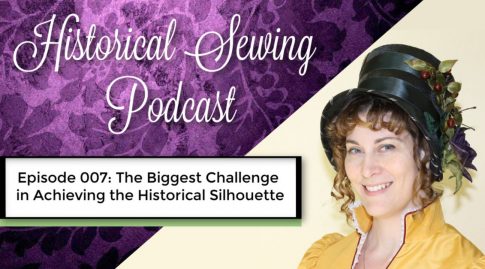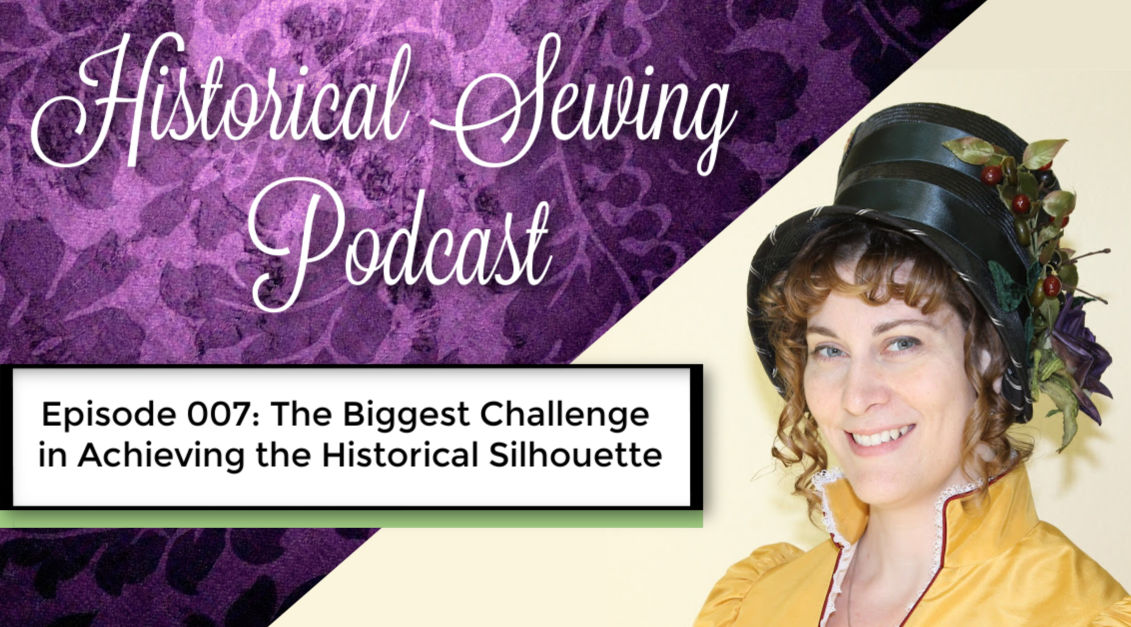
No matter how long you’ve been sewing and making historical ensembles, one of the biggest challenges that presents itself with each project is getting the silhouette “correct.” That look you create that identifies your costume as being from a specific fashion era and is recognizable as such.
The key is to work with your specific body type, with its assets and flaws, to get the right silhouette. In this episode Jennifer expands on this idea and gives examples that will have you re-think how you approach making undergarments.
Show Notes and Mentions
-Truly Victorian TV163 Imperial Bustle pattern (link to my Old Petticoat Shop)
-My online class: Bustle Day Dress
–Merja of Before the Automobile on Instagram
-Find Jennifer on Gab: @JenRosbrugh
Episodes are released on Wednesdays. Be sure to subscribe on iTunes to keep updated on new releases and have first access to new episodes as they are released.
Find the podcast on other platforms by visiting the Podcast page for links.
Contact us by email at sewing@historicalsewing.com or on our Contact Page.


I listened to this podcast yesterday, and I laughed at the Imperial Bustle example. I have the exact opposite issue; I definitely have a bubble butt, and what hips I have is from the requisite thighs that came with having said type of butt. A few weeks ago, I tried on my Imperial Bustle (I did the imperial version), and it was sticking out WAY too far, because the largest part of the curve on the bustle is about where my butt is. Combined with the fact that I’m short waisted, I’m worried that I’m just going to look like a bustle blob if I do Late Bustle Era.
I’m definitely a pear shape, and I realized early on that I was disappointed with the TV and LM corsets because they made what little I had in the chest area disappear, rather than support. It wasn’t until I made the TV Edwardian corset that I realized that corsets with gores were the way to go, so I’ve only used patterns with bust and hip gores since then. Definitely makes corsetmaking more challenging (especially since I’m using Ageless Patterns corsets), but the end result is much better.
It’s so much about working with our own unique body shapes!
I’m pear shaped too but carry my weight on my thighs rather than my bottom. Goes with how we are all different in how we need to approach working out the silhouette.
And YES to the corset gores and gussets! They definitely help to shape the curves. Glad to hear you’ve discovered a good solution!
Thank you for all this information, Jennifer! I’d love to try my hand at historical costuming, but I’m very tall and also broadly built, so I’m always afraid I’ll just look huge and ungainly. This episode has given me a lot more confidence to maybe give it a go after all.
One thing that I’m still worried about is the shoes. The dress/undergarments are of course the main components of an outfit, but if they’re not paired with the right shoes/hat/gloves etc it can really throw the whole look off. My dilemma is that I have big feet and usually shop in the men’s section of the shoe shops, being a EU 43/44, which I think translates to a US 12? 12ish, maybe. Do you know any fellow costumers that have the same problem, or would you know a place to look for appropriate footwear? I’m much less scared of corsetry than attempting to find the right shoes.
Thank you for sharing your knowledge so generously!
Oh, I’m so happy you are encouraged to move forward! YES – you can make historical ensembles even at your height. 🙂
I have friends who are in the US 12 size range for shoes. I think they look for basic dress shoes/pumps in the companies that they normally buy shoes from. Have a grand time on your sewing journey!
American Duchess makes historically accurate shoes for Rococo, Regency, Victorian, and Edwardian eras, and they go up to a size 11. Might be worth taking a look? They are mostly leather, so can be stretched somewhat. I do know the struggle! I wear a size 8, but double-wide, which is hard enough to find in normal shoes, never mind historical styles! It’s one of the biggest obstacles to my costuming hobby.
If a men’s medium width fits correctly, that’s a D width. Ladies’ medium is B. I have more sympathy than help (same build and shoe size; also hesitant about shoes).